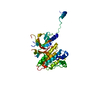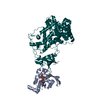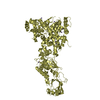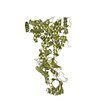Entry Database : PDB / ID : 3gopTitle Crystal structure of the EGF receptor juxtamembrane and kinase domains Epidermal growth factor receptor Keywords / / / / / / / / / / / / / / / / / / Function / homology Function Domain/homology Component
/ / / / / / / / / / / / / / / / / / / / / / / / / / / / / / / / / / / / / / / / / / / / / / / / / / / / / / / / / / / / / / / / / / / / / / / / / / / / / / / / / / / / / / / / / / / / / / / / / / / / / / / / / / / / / / / / / / / / / / / / / / / / / / / / / / / / / / / / / / / / / / / / / / / / / Biological species Homo sapiens (human)Method / / / / Resolution : 2.8 Å Authors Choi, S.H. / Alvarado, D. / Moravcevic, K. / Lemmon, M.A. Journal : Mol.Cell / Year : 2009Title : The juxtamembrane region of the EGF receptor functions as an activation domain.Authors : Red Brewer, M. / Choi, S.H. / Alvarado, D. / Moravcevic, K. / Pozzi, A. / Lemmon, M.A. / Carpenter, G. History Deposition Mar 19, 2009 Deposition site / Processing site Revision 1.0 Jul 7, 2009 Provider / Type Revision 1.1 Jul 13, 2011 Group / Refinement description / Version format complianceRevision 1.2 Mar 21, 2012 Group Revision 1.3 Nov 1, 2017 Group / Category Revision 1.4 Oct 20, 2021 Group / Category / struct_ref_seq_difItem / _database_2.pdbx_database_accession / _struct_ref_seq_dif.detailsRevision 1.5 Sep 6, 2023 Group / Refinement descriptionCategory / chem_comp_bond / pdbx_initial_refinement_model
Show all Show less
 Yorodumi
Yorodumi Open data
Open data Basic information
Basic information Components
Components Keywords
Keywords Function and homology information
Function and homology information Homo sapiens (human)
Homo sapiens (human) X-RAY DIFFRACTION /
X-RAY DIFFRACTION /  SYNCHROTRON /
SYNCHROTRON /  MOLECULAR REPLACEMENT /
MOLECULAR REPLACEMENT /  molecular replacement / Resolution: 2.8 Å
molecular replacement / Resolution: 2.8 Å  Authors
Authors Citation
Citation Journal: Mol.Cell / Year: 2009
Journal: Mol.Cell / Year: 2009 Structure visualization
Structure visualization Molmil
Molmil Jmol/JSmol
Jmol/JSmol Downloads & links
Downloads & links Download
Download 3gop.cif.gz
3gop.cif.gz PDBx/mmCIF format
PDBx/mmCIF format pdb3gop.ent.gz
pdb3gop.ent.gz PDB format
PDB format 3gop.json.gz
3gop.json.gz PDBx/mmJSON format
PDBx/mmJSON format Other downloads
Other downloads https://data.pdbj.org/pub/pdb/validation_reports/go/3gop
https://data.pdbj.org/pub/pdb/validation_reports/go/3gop ftp://data.pdbj.org/pub/pdb/validation_reports/go/3gop
ftp://data.pdbj.org/pub/pdb/validation_reports/go/3gop
 Links
Links Assembly
Assembly

 Components
Components Homo sapiens (human) / Gene: EGFR, ERBB1 / Production host:
Homo sapiens (human) / Gene: EGFR, ERBB1 / Production host: 
 X-RAY DIFFRACTION / Number of used crystals: 1
X-RAY DIFFRACTION / Number of used crystals: 1  Sample preparation
Sample preparation SYNCHROTRON / Site:
SYNCHROTRON / Site:  CHESS
CHESS  / Beamline: F1 / Wavelength: 0.918 Å
/ Beamline: F1 / Wavelength: 0.918 Å molecular replacement
molecular replacement Processing
Processing MOLECULAR REPLACEMENT
MOLECULAR REPLACEMENT Movie
Movie Controller
Controller










 PDBj
PDBj













